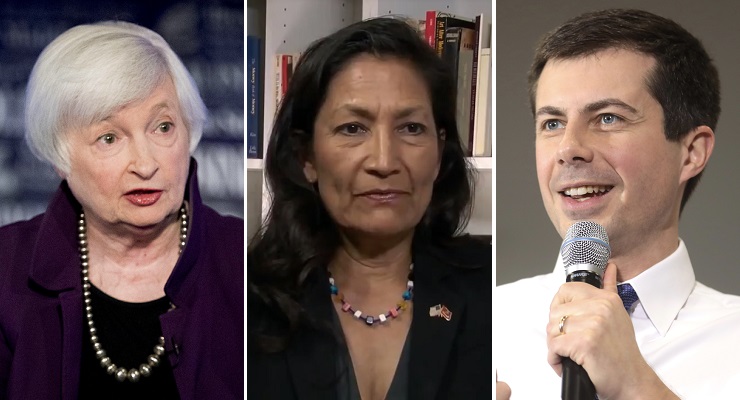
Two months into the new presidency, the Biden train is gathering steam. Two-and-a-half million COVID-19 vaccine jabs are being administered daily. Relief payments are landing in Americans’ bank accounts. State and local governments are dusting off their budget wish lists in advance of a federal funding windfall.
Next stop is a $3 trillion package to overhaul the nation’s crumbling infrastructure. Plus the most expansive electoral reforms in more than half a century.
While President Biden captures the spotlight for these initiatives, he knows better than most that an administration is only as good as the people who run it, and that the United States government is far too extensive to be ruled by fiat from the Oval Office. It’s why he vowed to nominate the most diverse cabinet in American history. And he has delivered on his pledge.
Biden’s cabinet comprises the 15 secretaries of executive departments, together with nine additional officials, and Vice-President Kamala Harris. With the exception of Harris and White House chief of staff Ron Klain, the other 23 officeholders require Senate confirmation. Only two roles remain unconfirmed.
Who has he tapped? Dr Janet Yellen is the first woman to lead the US Treasury, and the second oldest cabinet post. Yellen, who was the first woman to chair the Federal Reserve and also led the Council of Economic Advisers, is now the first person to hold the three key economic portfolios in US government.
Deb Haaland is the first Native American cabinet secretary, and the second Native American to ever serve in the cabinet. First elected to public office in the 2018 Democratic congressional blue wave, Haaland will run the Interior Department, which oversees most of America’s federal lands and natural resources. Nicknamed “the Department of everything else”, Interior also supervises programs affecting America’s indigenous populations. Two hundred and forty-five years after the Declaration of Independence, almost two centuries after the Trail of Tears, and 97 years after the end of the Apache Wars, the First Americans will be led again by one of their own.
Pete Buttigieg is the first openly gay person to serve in cabinet and the first cabinet official with a same-sex spouse. Coming just 24 years after Bill Clinton signed into law the inaptly named Defense of Marriage Act, this small step underscores the giant leap in societal attitudes in a single generation. Together with the first Second Gentleman, the mere presence of these spouses reflects a sea change in who is welcomed into the corridors of power.
Eleven women, six Black Americans, four Hispanic Americans, two Asian Americans and two immigrants: President Biden has kept his promise to appoint a cabinet that “looks like America”. Critics bleat that this is pandering to political correctness, and maintain their hollow claim that candidates should be chosen on “merit”. They are at a loss to explain why merit almost universally seems to result in white men running the show.
Consider Donald Trump’s cabinet of curiosities. In four years at the helm of a rotating cast, 83% of his picks were white. Three women served as departmental secretaries, none of whom endured to the end of his tenure. The lone Black American was Dr Ben Carson, a neurosurgeon and self-help author who had never held public office or managed a large enterprise. Not exactly ideal preparation for the Department of Housing and Urban Development.
Rick Perry, the longest-serving governor of Texas, was selected to run the Department of Energy. The irony that it was one of three departments he had boldly committed to abolish during his own presidential tilt was lost on him. It was also news to him that his department’s primary mission is to oversee America’s nuclear arsenal. That his two immediate predecessors under president Obama were a nuclear physicist and a Nobel laureate, rather than a good old boy from oil and gas country, should have been a clue.
Perry was most recently in the news during last month’s ice storm, insisting that Texans would rather be without power for days than suffer federal oversight. As governor, he ignored reports calling for an upgrade to Texas’ energy infrastructure after a similar blackout in 2011… and then went on to lead America’s key federal energy authority.
The litany of Trump’s crew is replete with similar miscasts. Only six survived his full term. In some respects this revolving door was unremarkable, given their boss proudly boasted of any challenge that “I alone can fix it!” However contrasting Biden’s cabinet with Trump’s also reveals that notions of merit are anything but objective. Self-important men failing upwards into prominent positions of power is as old as history itself. What’s radical is that we are living in an era where blind acceptance of that reality is no longer axiomatic.
The purpose of diversity in leadership is not to check boxes on a participation list. It’s to ensure that attitudes, experiences, knowledge and ideas at the apex of authority fully reflect and represent all people — not just a favoured few.
Study after study shows that diversity yields more creativity, improved performance and superior outcomes when compared to homogeneity. This applies in government, in business, in religion, in education, in sport — anywhere that humans congregate.
Joe Biden understands all this. His old boss ran for office on the wings of hope and change. Biden is bringing this vision back to life.








Nice. Someone should tell the LNP. Or rather, the next government
Biden ,same old!
Nice name.
“Self-important men failing upwards into prominent positions of power”
Now guess who the first name was that came to my mind. Australian, hasn’t held a senior job for more than 3 years before being found out and ‘let go’.
World hegemony with more diversity.